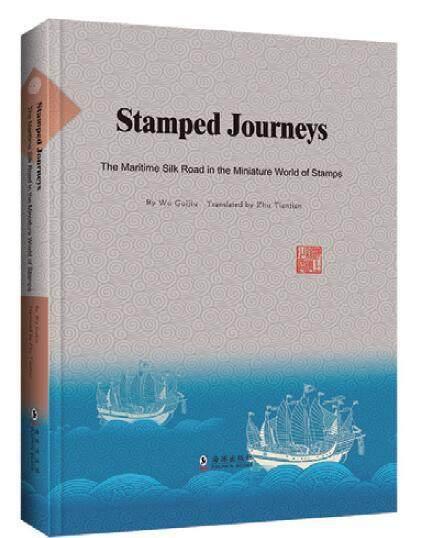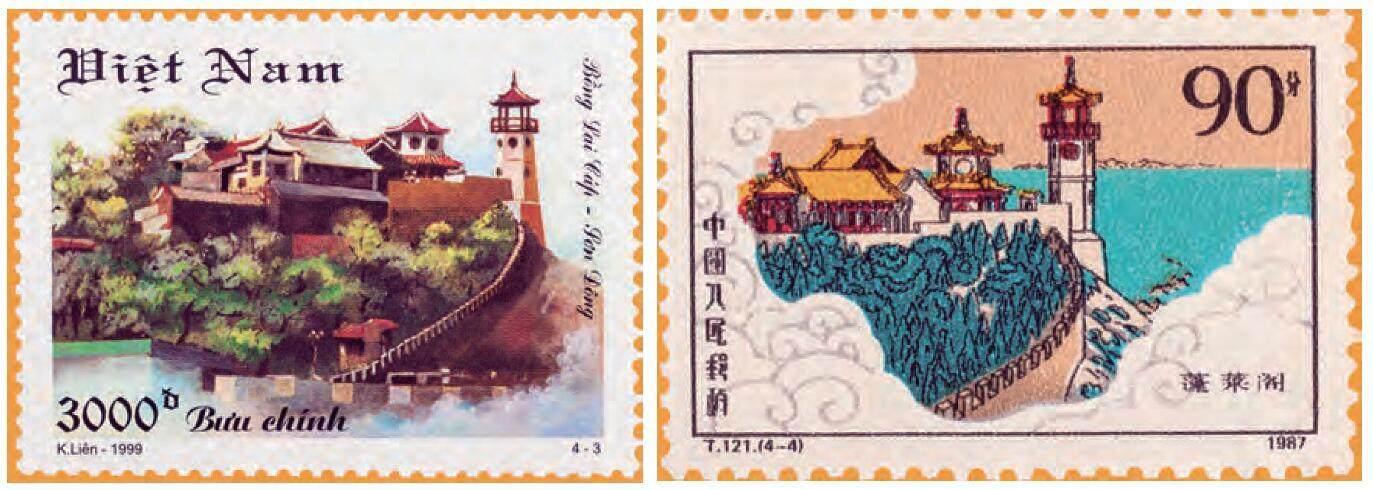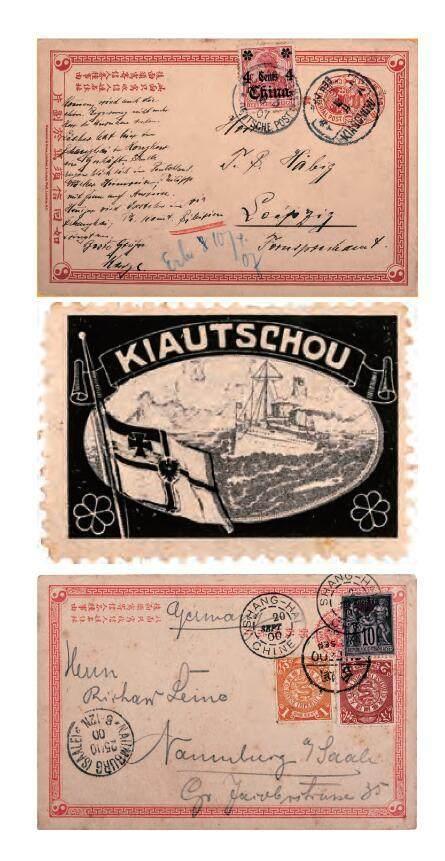East Sea Voyages
2024-05-14



Stamped Journeys: The Maritime Silk Road in the Miniature World of Stamps
Wu Guijiu
Dolphin Books
October 2022
228.00 (CNY)
Wu Guijiu
Wu Guijiu has worked in the Education Commission of Guangxi Zhuang Autonomous Region, the Development Research Center of the Peoples Government of Guangxi Zhuang Autonomous Region, and the Decision-making Advisory Committee of the Peoples Government of Guangxi Zhuang Autonomous Region. Since the 1970s, he has been collecting stamps and philatelic products related to Chinese and foreign cultures, especially the Silk Road, and has a rich collection. The thematic stamp collection “Maritime Silk Road” participated in the 17th National Philatelic Exhibition in Xian in 2016 and won the silver medal.
The East Sea voyages followed two routes. The northern route started from the Shandong Port group, including Dengzhou (now Penglai), Yantai, Qingdao, and Jiaozhou in Shandong, crossed the Dengzhou Channel, passed the Miaodao Islands to proceed to the Liaodong Peninsula, and finally reached the Korean Peninsula and the Japanese archipelago. This route was popular in the early stages of the Spring and Autumn Period (770 BCE--476 BCE), and the Warring States Period (475 BCE--221 BCE) when maritime skills had not yet developed. The southern route left from the port group to proceed along the coast of Jiangsu and Zhejiang, including Nanjing, Yangzhou, and Ningbo, going directly to the Korean Peninsula and the Japanese archipelago through the south of the East China Sea.
Traveler on the Silk Road
Xu Fu was an alchemist of the Qin Dynasty. He is said to have popularized rice cultivation, smelting, weaving, tea planting as well as the Chinese characters used for writing in Japan. The Japanese believe that farming, sericulture, medicine, smelting, and even shipbuilding and navigation were introduced to Japan from China by Xu Fu. He made outstanding contributions to the progress of ancient Japanese society and civilization, and the people revered him as the “God of Farming” and “God of Medicine.” In Saga Prefecture on Kyushu Island, there is a memorial saying, “Xu Fu landed here.” In the village of Hadasu in Kumano and other places, there are Xu Fu tombs. The tombstone in Shingu City was originally engraved with the words “Tomb of Xu Fu of the Qin Dynasty.” There is a Jofuku no Miya Shrine (Shrine of Xu Fu) in the Asuka-jinja Shrine in the Kumano region and a Xu Fu Temple by Mt. Horaisan.
The tombs of Xu Fus descendants were discovered by Japanese archaeologists in Myozeni Temple in Fujisawa City, Kanagawa Prefecture, around 2005, which housed the graves of generations of a family known as the Fukuokas. The tomb inscriptions indicated that Xu Fu of the Qin Dynasty was their ancestor, and the family name “Fukuoka” was taken from his first name, “Fu,” so that his descendants would not forget their ancestor and homeland. Additionally, there is a Seobok (Xu Fu) Memorial Hall in Seogwipo, a large city on Jeju Island, the Republic of Korea. It is said that Xu Fu traveled east to Japan and returned westward to China. During his voyage, he first stopped in Yingzhou and carved “Xu Fu passed here” in Chinese characters on the cliff of Jeongbang Falls, a scenic spot in Yingzhou. The name Seogwipo, literally meaning returning westward, may have come from that.
Xu Fu traveled along the maritime trade route established in the Spring and Autumn Period to arrive in Japan. The voyage propagated Chinese culture overseas and opened up the sea route for more large-scale personnel and cultural exchanges in the later dynasties.
Port of the Silk Road: Penglai
It was originally a town established in the Tang Dynasty (618--907). The office of Dengzhou Prefecture was set up there, and the town was upgraded into a county. It was an important port on the Shandong Peninsula, offering the shortest route to the Korean Peninsula and the Japanese archipelago. When Xu Fu sailed to the east during the Qin Dynasty, Penglai was an important port for exchanges between China, the Korean Peninsula, and the Japanese archipelago. In the Sui (581--618) and Tang dynasties, the Silla and Koryo pavilions were set up in Dengzhou to receive envoys from the Korean Peninsula and the Japanese archipelago, respectively. In 1376, Dengzhou became a prefecture as the number of people coming to China from Korea and Japan grew. In the Qing Dynasty, Dengzhou governed one district and nine counties, which is equivalent to all the cities and counties in Yantai and Weihai now. “Merchants gathered here to make the city prosperous, with music everywhere.” “Ships keep coming and leaving here. Merchants and envoys are flocking.” These sentences vividly illustrate the prosperity of ancient Dengzhou.
The Northern Route of the East Sea Voyages: Departure from the Shandong Peninsula Port Group
According to historical records, the Shandong Peninsulas overseas exchanges can be traced back to the Xia (2070--1600 BCE) and Shang (1600--1046 BCE) dynasties. It is recorded that Jizi, the uncle of King Zhou of the Shang Dynasty, introduced the rites and systems of the dynasty to the north of the Korean Peninsula after the fall of the dynasty. During the Spring and Autumn Period and the Warring States Period, the Qi, Wu, Yue, Chu, Yan, Zhao, and other states started to trade with foreign countries due to political and economic interests. The Qi State in the Spring and Autumn Period attached great importance to overseas trade, regarding it as a primary measure for development. It opened up a maritime trade route starting from the coastal areas in the Shandong Peninsula to the Korean Peninsula in the east, which pioneered the overseas trade initiated and organized by the government. Qi State relics were mainly found in the southern part of the Korean Peninsula (todays Republic of Korea), while the objects found in the northern part were mostly from the Yan and Zhao states. This indicates that in the Warring States Period, the Yan, Zhao, and Qi states had different routes to go to the Korean Peninsula for exchanges. While Yan and Zhao accessed the peninsula from the north by land, Qi went there by sea. It was a safe and convenient route that went mainly past the Miaodao Islands and along the coastline to enter todays Republic of Korea from the west coast of the southern Korean Peninsula.
According to Historical Records by historian Sima Qian of the Western Han Dynasty, the first emperor of the Qin Dynasty sent Xu Fu to Japan twice in search of the elixir of life. It is said that about 3,000 people traveled with him, including the ships crew and artisans from different fields. In recent years, scholars from China, Japan, and the Republic of Korea, after researching the voyages of Xu Fus fleet from multiple disciplines, such as archeology, history, navigation, and folklore, all agreed that he went from the Shandong Peninsula to the Korean Peninsula and proceeded to the Japanese archipelago.
As early as the Western Han Dynasty, the Japanese had contact with China through the Korean Peninsula. From the Sui Dynasty, Japan sent large cultural missions to China to learn various things. The early Japanese envoys to the Tang court went northward along the west coast of the Korean Peninsula, then southward along the southeast coast of the Liaodong Peninsula, crossed the Bohai Bay, landed in Dengzhou, and went westward by land to the cities of Luoyang and Changan. This route was relatively safe since it was mostly along the coast. From 670 to 760 CE, the Silla Kingdom controlled the Korean Peninsula, so the Japanese had to go south from Kyushu, along the Tanegashima, Yakushima, and Amami islands, then northwest across the East China Sea, finally reaching Yangzhou. This route was dangerous because it was mostly in the boundless East China Sea. After 760 CE, they shifted to crossing the East China Sea from southwest of the Goto Islands in the west of Kyushu, went to Mingzhou (now Ningbo), and then headed north via the Beijing-Hangzhou Grand Canal.
In the Tang Dynasty, the kingdoms of Koryo, Baekie, and Silla in the Korean Peninsula had close contact with China. Envoys were sent by both sides, traveling by land and sea. There is a reference to that in Tang poet Qian Qis Seeing Off Imperial Clerk Lu Ting to Silla: “The envoy, appointed by the emperor, was seen off by the whole city.” The king of Silla frequently sent envoys to Changan with precious gifts, and the Tang court often gave Silla exquisite silk in return. Silla also sent a large number of students to study in Changan. They were the largest group among the international students during the Tang Dynasty, and even took the imperial service examination. They went back to Silla, taking various Chinese cultural classics with them. The decrees and regulations, as well as the Confucian culture of the Tang Dynasty directly influenced the culture in the Korean Peninsula. For instance, Choe Chiwon (857--?), a noted Korean poet and official, was known as a master of Confucianism.
In the Tang Dynasty, trade with the Korean Peninsula flourished. Many Silla merchants came to China and visited many places. They went up to Dengzhou and Laizhou (now in Shandong) in the north and Chuzhou (now Huaian, Jiangsu) and Yangzhou in the south. There were Silla pavilions in Dengzhou and Chuzhou and Silla lanes in Laizhou and other places with a sizeable Silla population. Silla merchants brought cattle, horses, ramie fabrics, ginseng, and other goods, which they exchanged for silk, tea, porcelain, medicinal materials, and books. Goods from Silla topped Chinas imports.
Traveler of the Silk Road Zheng He (1371--1433?), the renowned Chinese navigator, was born in Yunnan during the Ming Dynasty. Originally named Ma He, he was from the Hui ethnic group. He helped Zhu Di to become the Yongle Emperor and was subsequently conferred the surname Zheng by the emperor. Both his father and grandfather had been to Mecca, the holy city of Islam, so he knew about foreign countries from a young age. During his seven expeditions commissioned by the Ming emperor, he visited over 30 countries and regions and reached as far as the east coast of Africa, more than half a century earlier than Columbus and Vasco da Gama. Zheng Hes voyages to the West helped to open up economic and cultural exchanges as well as established diplomatic ties with Asian and African countries and regions. Wherever he went, he brought local people agricultural expertise and life skills, such as rice planting, mulberry planting, silkworm rearing, and tea cultivation. He also traded Chinese silk, ceramic products, as well as gold, silver and iron wares in exchange for local specialties and promoted economic and cultural exchanges. Never before had the world seen such long voyages with such a large fleet. Zheng Hes voyages were also known for their meticulous operation and use of advanced technologies.
His fleets consisted of up to 250 large ships, with the largest about 150 meters long and 60 meters wide and able to accommodate 1,000 people. On each voyage, he was accompanied by a crew of more than 25,000. In contrast, on Columbuss first voyage, his fleet consisted of three sailboats and about 88 sailors, and the largest ship was less than 250 tonnes. Vasco da Gamas fleet had four ships and around 160 seamen, and the largest ship weighed 120 tonnes.
杂志排行
中国新书(英文版)的其它文章
- Dujiangyan
- Traditional Chinese Crafts in the Context of Silk Road Civilization -- Interview with Master Li Maodi, a Master of Zhuoni Tao Inkstone Making in Gansu’s Zhuoni
- Encounters and Cultural Boundaries Between East and West: Cultural Transmission Under the Belt and Road Initiative
- The Splendor of the Maritime Silk Road: A Major Theme of Globalization Leading to the Americas
- Revelations from the Civilizations of the Silk Road
- The Historical Context of the Silk Road
